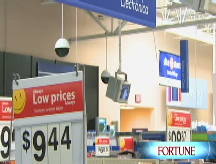Consumer spending drops 1%
Personal spending drops by most in seven years as consumer prices fall; personal income higher than forecasts.
NEW YORK (CNNMoney.com) -- Consumer spending fell dramatically in October, according to a government report released Wednesday, in another woeful sign that the economy will continue to contract.
The Commerce Department said spending by individuals fell by 1% last month, after declining 0.3% in September. It was the biggest decline since September 2001 and worse than the 0.7% drop economists surveyed by Briefing.com had forecast.
"This is just more confirming evidence that the fourth quarter got off to a worse-than-expected start," said Sam Bullard, economist at Wachovia. "It's a function of businesses and consumers retrenching and paying down debt."
Falling consumer prices contributed heavily to the decline in overall spending. The so-called core PCE deflator rose by just 2% in the past 12 months, down from 2.2% by that measure in September.
This key reading, which measures prices paid by consumers for goods and services other than food and energy, is now in the 1% to 2% inflation window the Federal Reserve is generally believed to want, and it echoes a Labor Department report released last week that showed consumer prices fell by the highest amount since 1947.
But the report showed spending still fell by 0.5% when prices were not taken into account.
That's an ominous sign ahead of the holiday shopping season. It's particularly worrisome for the economy since consumer spending accounts for more than two-thirds of the nation's gross domestic product.
"It's going to be an ugly fourth quarter," said Bullard, who expects the economy to shrink by 4% in the current 3-month period, down from 0.5% last quarter. "We won't see a recovery until the second half of 2009 and even then it will be a sluggish recovery."
Much of the spending decline was because of plummeting durable goods spending, which fell 3.8%, dragged down mostly by fewer purchases of automobiles and motor vehicle parts. A separate report showed advance orders for durable goods fell 6.2% in October - the biggest decline in 2 years.
Bullard said the deteriorating job and housing markets have led consumers to pay down debt rather than buy expensive big-ticket items.
Personal income, however, rose 0.3% in October, following a 0.2% rise in the previous month. Economists had expected a 0.1% rise.
The rise in personal income far outpaced the change in prices, leading to a 1% rise in real income in the period, the most since September 2005.
Because income gains outpaced spending, consumers posted a savings rate of 2.4% in the month compared with just 1% in September. That means the average household saved $2.40 on every $100 of after-tax income.
"Income came in higher than expected, but people are not going out and spending it," Bullard said. "Unless they spend it, it's not much help to the economy."
To try to jump-start consumer spending, the government unveiled an $800 billion bailout for holders of assets backed by credit card debt, auto loans and mortgages. Some $200 billion of that is devoted to purchases of consumer debt-backed securities, which the government hopes will lead to more lending to consumers and increased spending.
President-elect Barack Obama has also stated his support for another economic stimulus package. But the last stimulus package only provided a short-term boost to the economy in the second quarter.
Bullard said further government intervention will help but that the natural business cycle needs to play out before spending will recover.
"The government can prevent the worst-case scenario, but the impact won't be seen anytime soon," said Bullard. ![]()


